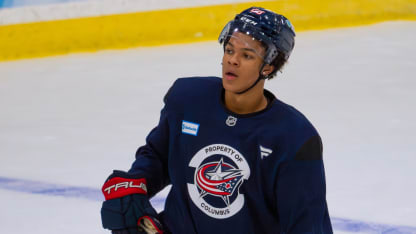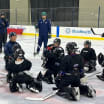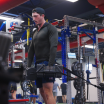Lindstrom is back on the ice after a year that made him a much stronger person. Soon after returning to Medicine Hat to win the WHL championship and play for a Memorial Cup, he participated fully in the Blue Jackets’ 2025 development camp. Last week, he represented Team Canada at the World Junior Summer Showcase in Minneapolis, and he’s set to begin his college career at Michigan State this fall.
Gearing up for his first full season of hockey in three years, it’s what Lindstrom has learned off the ice that will prepare him for what’s to come on it.
“Before, I would think too far ahead, or maybe think about things in the past, but now I know that every day is going to be different and not every day is going to be the same,” Lindstrom said. “You're going to have highs and lows and good days and bad days, but it's a mental challenge every day. So as long as you're mentally strong and you can get through those days, you're gonna be great one day or another.”
The Process
In British Columbia, hockey is all there is to know.
Lindstrom spent hours upon hours on skates, in weight rooms, shooting pucks – much like the rest of the youth in the province. British Columbia has produced some of hockey’s most impressive young talents in recent years, including a pair of first overall draft picks (Connor Bedard in 2023 and Macklin Celebrini a year later) among other rising stars.
When kids like Lindstrom could walk, they were on skates. Once they were on skates, they were in gear, stick in hand. Living out of hockey bags and bouncing between different locker rooms, trekking hours upon hours away for tournaments, pushing through multi-game weeks, extra skates and lifts and workouts.
It introduces a fundamental habit – a questionable one, at that – instilled in practically every hockey player: never stopping.
“Growing up,” Lindstrom said, “even if I got hurt, I would always play through it. I mean, that’s how I was really taught growing up, that blue-collar mentality.”
Even if a muscle was tweaked, if you felt a little sore around your bones, if a bruise was feeling particularly swollen or vulnerable – taking one day off could be the difference between getting first-line minutes or second-line minutes. Perhaps that day you’d take off would be when NHL scouts were in the building, and they wouldn’t be noticing you, and would notice your teammate instead.
It reached a boiling point in perhaps Lindstrom’s most important year of development – his draft year.
“I got the initial injury in October (2023),” Lindstrom said. “I didn’t really know what it was, and I didn’t look too much into it, because obviously that wasn’t my main focus.”
The initial injury was a disk issue in his back, something he tweaked and never felt quite the same. Lindstrom did what he could to mitigate the pain, perhaps some extra stretching exercises or little treatments that could alleviate the symptoms enough.
As the strenuous WHL schedule kept on pushing, Lindstrom kept on producing – 27 goals in 32 games, confirming his status as a potential top draft pick. But in December, Lindstrom said, things “started getting out of hand.”
“That’s when I actually broke my hand,” Lindstrom said. “And then that’s when I just finally decided to start really looking into my body and seeing what was wrong.”
The Recovery
Before Lindstrom took the ice for Game 1 of the WHL Championship Series this spring, and before he posted two goals and four points in his first four games back from injury after a whole year, Lindstrom took his time.
By then, his warmup routine was down to a science – he ensured his body was ready with a series of stretches and exercises that teetered on the edge of 45 minutes.
“I like to get pretty warm,” Lindstrom said with a laugh.
Every hockey player has their own routine. Some might eat the same thing before games, while others might take time to retape their sticks or – like Lindstrom – spend close to an hour warming up their bodies.
After staying in Columbus for the 2024-25 season to rehab and spending endless hours with his future CBJ teammates, Lindstrom picked up the little habits that worked for each player and incorporated them into his own routine.
“Everyone has their own different routines that are built specifically for them,” Lindstrom said. “Whatever works for you to keep you healthy and strong is the best thing for you.”
Lindstrom underwent a microdiscectomy last November, a procedure that helps relieve pressure when a disk is rubbing up against a nerve. He had the option to rehab back at home or in Medicine Hat, stay close to family or his teammates. But then another option arose, one that would allow him to stay in Columbus and rehab with the trainers there, eventually skate with the Blue Jackets, and recover at an NHL facility.
The decision was a no-brainer.
“I don’t think there was a better place I could have been,” Lindstrom said.
For an 18-year-old kid used to long bus rides in Canada and the grind of the WHL season, slowing down and indulging in the professional facilities was appealing. Between the trainers, the weight room, massage therapists, hot tubs and cold tubs, chefs — Lindstrom was given all the resources he needed to recover from the surgery.
Yet for Lindstrom, he quickly learned that recovery went far beyond post-operative rehabilitation.
Part of what he learned came from James van Riemsdyk, a player that’s had a long career in the NHL despite enduring countless injuries. There might have been a 17-year age gap between the two players, but while Lindstrom overlapped with Blue Jackets players in and out of the locker room, they were quick to offer the prospect invaluable advice.
“‘Listen to your body,’” Lindstrom recalls van Riemsdyk saying to him. “‘Don’t listen to the outside noise and people pressuring you. Just do what you think will make you better and have a long career.’”
So Lindstrom listened, and he listened to everyone – what moves work best at physical therapy, what would amplify his pain and what wouldn’t, how to keep something like this from happening again. He quickly learned that recovery was more than just physical, more than stretching or lying down after a hard workout.
“I think sleep is a huge factor in recovery,” Lindstrom said. “I really dialed in all my sleep, my nutrition. … I just think those things have really helped me excel in my rehabilitation.”
There was the mental aspect of recovery, too. For a player used to being one of the best on the ice, having to put in the work to get back to that level was a difficult process.
“Those couple months when I started skating, it was tough mentally,” Lindstrom said. “But I think it's built me mentally stronger and in the best way possible.”
Between the operation to the WHL Championship Series, just six months had passed. But that time was enough to change him fundamentally, battling – and persevering – through a recovery process that would challenge even the most accomplished professionals.
Lindstrom is quick to credit the people around him for how he’s developed. But those who met Lindstrom throughout the process noticed something different about him.
“He’s really mentally strong,” said Rick Nash, the Blue Jackets director of hockey operations who works closely with the team’s prospects. “You think about an NHL player that’s played a couple years pro, for him to go through a six-week injury – everyone talks about how his head space is, and Cayden’s been through a lot more than that.
“He works at it. It’s important as a development staff, too. You’re working on the ice, you’re working off the ice, but you’re also working between the ears, which is very important. That’s probably one thing that’s impressed me about Cayden.”
What has gone unsung about Lindstrom’s impressive recovery process is how he’s changed “between the ears.” Lindstrom is a quiet leader, but when he talks, you quickly forget he just turned 19 a few months ago.
“My whole life has been hockey,” Lindstrom said. “You could ask my mom or my grandpa or whoever you want – I’ve dedicated so much to the sports and so many hours, and just being hit with an injury like that, you kind of see that hockey isn’t the only thing for you.”
Each week during his recovery in Columbus, Lindstrom’s coaches in Medicine Hat would reach out to check in on how he was doing. He’d call his mom and his younger sisters, who’d just gotten phones and began incessantly texting him. He talked with his Tigers teammates every day.
He formed relationships with current Blue Jackets, too. Eric Gudbranson and Kent Johnson were just a couple of players that Lindstrom became close with. He and Johnson, a fellow native of the Vancouver area, still keep in touch.
Those relationships, Lindstrom said, are what he knows transcend hockey, and what will last once Lindstrom wraps up what will be a long and promising career. Perhaps the most pivotal piece of his recovery process was realizing that.
“Keeping your family and your relationships close to you and having those tough conversations with your family (is) really meaningful,” Lindstrom said. “It can help you in so many different ways. I mean, hockey is just a small part of your life, and you have so much more ahead of you than just hockey. I think that that was a really big eye-opener for me.”
In a few short months, Lindstrom will take the ice for Michigan State as one of the many highly touted Canadian Hockey League prospects switching gears to the NCAA. Though he feels “pretty much 100 percent in the gym,” he says there’s still work to be done before he plays like the prolific power forward he once was before the injury.
At the same time, though, Lindstrom is happy with who he is now. He’s learned that recovery isn’t merely reverting back to his old self but continuing to grow into a stronger person with each rep, stride and stretch.
“I think everything happens for a reason,” Lindstrom said. “I'm not really where I want to be yet, but things take time, so I'm not worried about it. I think I'm a really hard worker and I'm very dedicated (to) the sport, and I have a lot of passion for the game, so I think I'll get there pretty soon.”




















